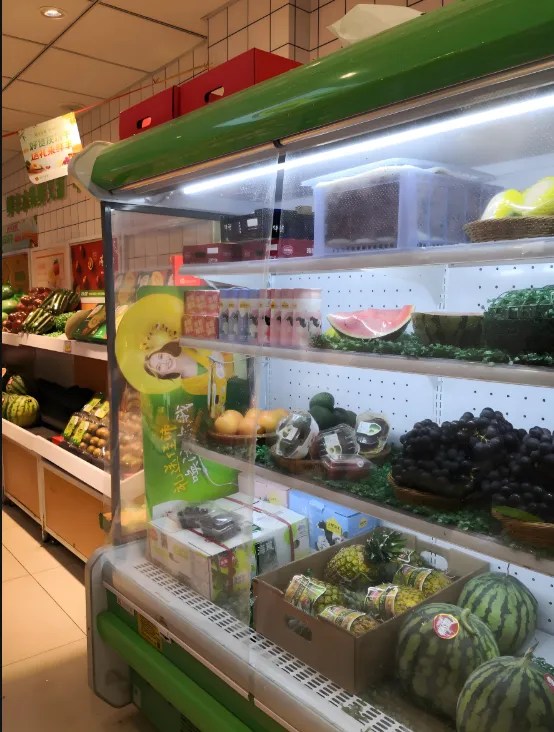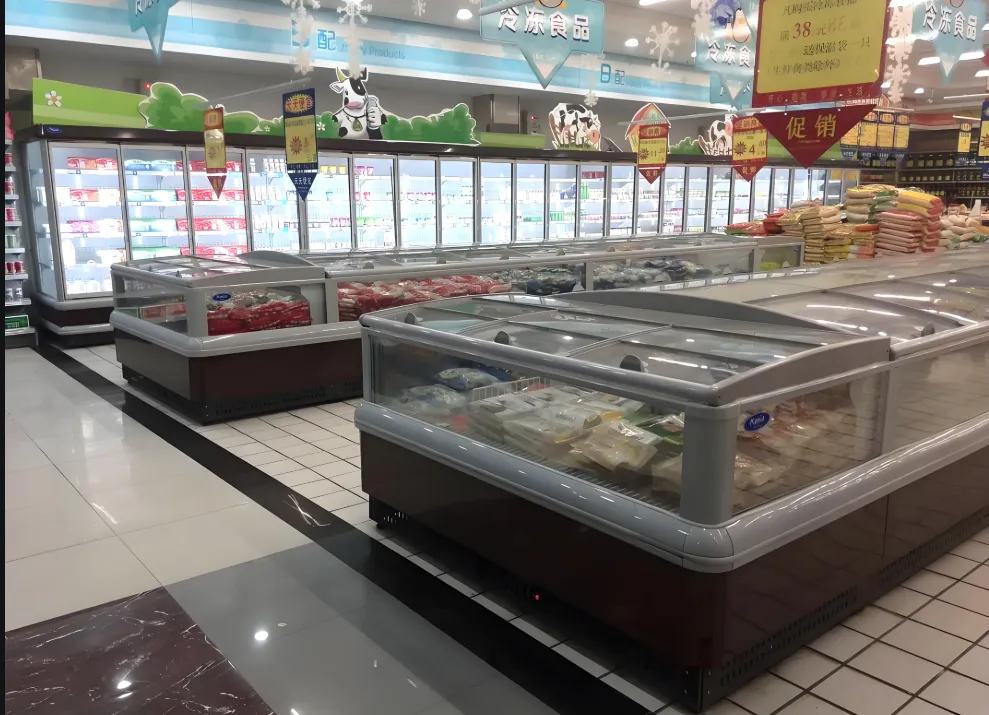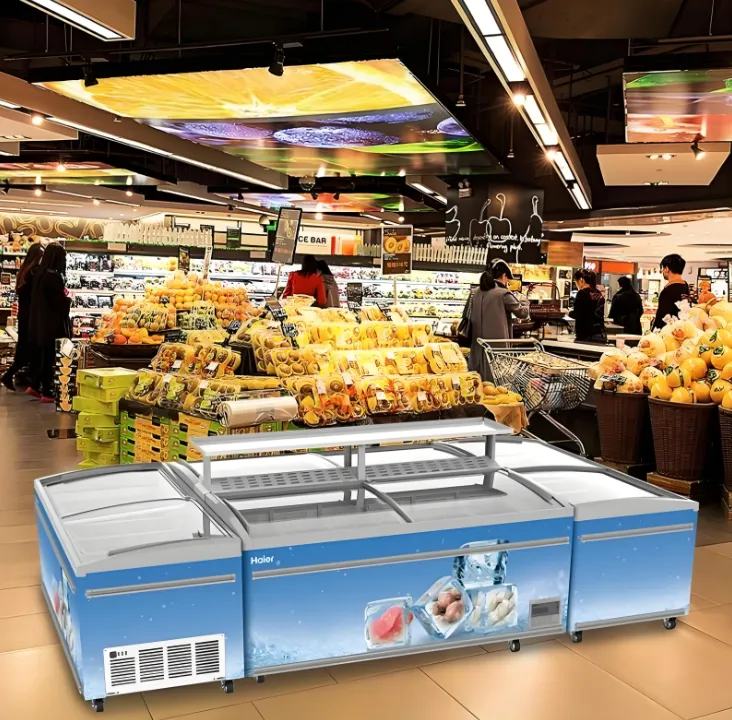
The following table visualizes the basic differences between the two structures:
|
Contrast dimensions |
Single glazing |
Double insulating glass |
|
Number of glass layers |
1 floor |
2 layers |
|
Total thickness |
3-6mm |
12-24mm (with air layer) |
|
Heat Conduction Path |
Single glass conduction |
Glass-air-glass composite conduction |
|
Light transmittance |
Approximately 91% |
Approx. 85%-88% (affected by air layer) |
|
Impact strength |
Ordinary glass is lower and lifted after tempering |
On the basis of tempered glass, the structure is more stable |
|
Manufacturing costs |
low |
High (material + sealing process cost) |

Cost sensitive
1: The price of household freezers is usually 1000-3000 yuan, and single-layer glass can reduce the cost by 10%-15%, which is attractive to price-sensitive consumers.
Gentle use environment
2: The indoor temperature of the home is relatively stable (18-26°C), the internal temperature of the freezer is mostly refrigerated (2-8°C) or lightly frozen (-12°C), the temperature difference is smaller than that of commercial scenarios, and the heat transfer of single-layer glass is acceptable.
Space constraints
3: Household freezers are usually embedded in cabinets or placed in small spaces, and the thickness of double-layer insulating glass (12-24mm) will take up more space, while single-layer glass (3-6mm) is thinner and more adaptable.
Exceptions:
High-end home freezers: Some high-end brands (such as Sub-Zero) use double-walled hollow Low-E glass or even vacuum glass for ultimate performance
Special environment households: For example, in tropical homes or kitchens without air conditioning, double-glazed freezers may be chosen to reduce energy consumption and condensation
5. Condensation control: precise management of glass surface temperature
Condensation control is one of the core considerations in the design of freezer glass, as condensation not only affects visibility, but can also lead to frost on glass edges, rust on cabinets, and even electrical safety.
(1) The thermodynamic mechanism of condensation
When the surface temperature of the glass is lower than the dew point temperature of the ambient air, the water vapor in the air will condense into water droplets on the surface of the glass, which is the phenomenon of condensation. Dew point temperature is related to ambient temperature and humidity, such as:
At ambient temperature 25°C and humidity 60%, the dew point temperature is approximately 15.5°C
If the internal temperature of the freezer is 4°C, the surface temperature of the single layer of glass (thermal conductivity 5.8W/(㎡・K)) can be calculated by the formula:
\(T_s = T_{inside} + (T_{outside} - T_{inside}) \times \frac{R_{glass}}{R_{total}}\)
thereinto
\(R_{glass} = \frac{0.005}{0.78} = 0.0064 m²· K/W\)
(5mm glass thermal resistance),
\(R_{total} = R_{glass} + R_{air}\)
(Air thermal resistance is negligible), calculated\(T_s ≈ 7.8℃\), below the dew point temperature of 15.5°C, it will inevitably fog up.
Total thermal resistance of double-layer insulating glass (U=2.8).
\(R_{total} = \frac{1}{2.8} = 0.357 m²· K/W\)
, calculated surface temperature\(T_s ≈ 22.4℃\), much higher than the dew point temperature, will not fog up.
(2) Condensation control advantages of double-layer insulating glass
Double-walled insulating glass enables efficient condensation control through the following mechanisms:
Air layer insulation
: Greatly reduce the temperature difference between the inner and outer surfaces of the glass, so that the temperature of the outer surface is close to the ambient temperature, and avoid being lower than the dew point.
Edge heating technology
: Some high-end commercial freezers will install electric heating wires (power about 5-10W/m) on the edge of the insulating glass to further increase the edge temperature and prevent condensation in the corners.
Sealing system is moisture-proof
: The desiccant continuously absorbs moisture in the air layer, avoiding condensation inside and extending the service life of the glass.
(3) Condensation countermeasures for single-layer glass
In scenarios where single-layer glass must be used, the following compromises are often employed:
Surface coating
: Coating anti-fog film to reduce the surface tension of water, so that the condensate forms a thin water film instead of water droplets, keeping the line of sight clear, but the validity period is limited.
Ventilation design
: Set up a small fan near the freezer glass to speed up the air flow and increase the surface temperature, but it will increase energy consumption and noise.
Wipe regularly
: Manually wipe the condensate regularly, suitable for domestic or small commercial scenarios, but increase maintenance costs.
6. Energy saving benefits: look at the technical value from energy consumption data
In the context of the global energy crisis and carbon emission control, the energy-saving performance of freezers has become an important technical indicator, and the energy-saving advantages of double-layer insulating glass show great value in large-scale applications.
(1) Quantitative analysis of energy consumption comparison
Take a brand of 250L freezer as an example, under standard test conditions (ambient temperature 32°C, humidity 55%):
Single-layer glass freezer: 1.2 kWh of electricity per day and 438 kWh per year
Double-layer insulating glass freezer: daily electricity consumption of 0.8 kWh, annual electricity consumption of 292 kWh
The annual electricity saving is 146 kWh, which is calculated based on the commercial electricity price of 1.2 yuan/kWh, and the annual electricity bill is 175.2 yuan
For large commercial users, such as a supermarket with 50 freezers, the annual electricity bill can be saved: 175.2×50=8760 yuan, and the difference in freezer purchase costs can be recovered in 3 years (assuming that each freezer is 1000 yuan more expensive, 50 units are 50,000 yuan more expensive, 8760×3=26280 yuan, which has not been fully recovered, but the net income starts in the 4th year).
(2) The system effect behind energy conservation
The energy savings of double-walled insulating glass are not only reflected in the glass itself, but also lead to the overall optimization of the freezer system:
Compressor load reduction
: Reduced cooling loss means shorter compressor start-up frequency and run time, longer compressor life and lower maintenance costs.
Refrigerant dosage optimization
: The reduction of the cold load can appropriately reduce the amount of refrigerant charge, save material costs, and reduce the risk of leakage.
Thermal insulation design adjustment
: In the overall thermal insulation design of the freezer, the glass door is the thermal bridge part, and the double-layer insulating glass can reduce the requirements for the thickness of the insulation layer in other parts and save the cost of cabinet materials.
(3) The promotion role of policies and standards
Energy efficiency standards in various countries have a direct impact on the choice of refrigerator glass:
EU Energy Efficiency Label
: From A+ to G, double-wall insulating glass is necessary to achieve a high energy efficiency rating (A+++).
US ENERGY STAR certified
: The heat loss rate of freezers is required to be lower than a certain threshold, promoting the popularization of double glazing.
China Energy Efficiency Label
: The updated standards in 2021 have increased energy efficiency requirements, and it is expected that double-walled insulating glass will be commonly used in commercial freezers in the future.
7. Manufacturing process evolution: from simple cutting to precision sealing
The manufacturing process of freezer glass has evolved with technological demands, and the production of single and double glazing reflects different process complexities.
(1) Standardized production of single-layer glass
The production of single-layer freezer glass is highly automated, and the main processes include:
Glass cutting
: Adopts CNC cutting machine, with an accuracy of ±0.5mm, suitable for mass production.
Edging
: Chamfering by linear edging machine to prevent edge scratches and improve safety.
Tempering (optional)
: Heating the glass to 620-650°C, then cooling it quickly to form a compressive stress layer and increase the strength. The glass size shrinks by around 0.3% during tempering, requiring precise control.
Wash and dry
: Surface stains are removed by ultrasonic cleaning machine to ensure transparency.
(2) Precision manufacturing of double-layer insulating glass
The production of double-layer insulating glass requires more complex equipment and processes, and the core links include:
Aluminum spacer processing
: The aluminum strip is processed into a rectangular frame using a press brake, and the corners are spliced at 45° to ensure the regularity of the sealing cavity, and the air permeability holes are evenly distributed on the spacer strip for easy desiccant filling.
Desiccant filling
: Fill 3A or 4A molecular sieve inside the aluminum strip to absorb moisture and impurities in the air layer, the filling amount is calculated according to the volume of the air layer, usually 5-8g per meter of spacer strip.
Laminated and sealed
: Superimpose two layers of glass with aluminum spacers, first apply butyl glue (hot melt sealant, thickness 0.3-0.5mm), and then seal the outer layer with silicone glue to form a double-channel sealing system. The curing time of sealants typically takes 24-48 hours, and temperature and humidity have a significant impact on the curing effect.
Inert gas filling (optional)
: Argon or krypton gas is injected into the air layer through the inflatable equipment, and the inflation pressure is slightly higher than the atmospheric pressure to prevent air infiltration in subsequent use, and the air tightness test is required after inflation.
(3) Process difficulties and quality control
The manufacturing difficulties of double-layer insulating glass are:

The seal fails
: Uneven sealant coating or incomplete curing will cause air leakage in the air layer and reduced thermal insulation performance, so it is necessary to test the sealant thickness and continuity online.
Desiccant failure
: If the desiccant filling is insufficient or the adsorption is saturated, condensation will appear in the air layer, which will affect the service life, usually verified by the dew point test (no condensation below -40°C).
The glass stress is uneven
: The difference in tempering stress between the two layers of glass may cause the insulating glass to warp and affect the sealing, and the tempering process parameters need to be strictly controlled.
8. Safety and durability: hidden requirements beyond function
In addition to performance and cost considerations, the design of refrigerator glass also needs to meet safety specifications and durability requirements, which is especially important in public use scenarios.
(1) Impact resistance and explosion-proof performance
Safety benefits of tempered glass
: Whether it is single-layer or double-layer insulating glass, freezers usually use tempered glass, which has an impact strength (≥50MPa) much higher than ordinary glass (≤20MPa), and is broken into honeycomb-like obtuse angled fragments, which meets the safety requirements of GB 15763.2 "Safety glass for construction - Part 2: Tempered glass".
The enhancement effect of the double-layer structure
: The two layers of tempered glass are bonded by sealant to form a composite structure, and the impact resistance is improved by 20%-30% compared with the single-layer tempered glass, which can effectively resist accidental impacts (such as shopping cart collisions).
(2) Weather resistance and service life
Aging resistance of the sealing system
Sealants for double-walled insulating glass need to withstand temperature changes (-40°C to 70°C) and UV exposure, with silicone adhesives typically lasting up to 10-15 years and butyl adhesives longer (more than 20 years) to ensure long-term airtightness.
Resistant to frost and corrosion
: If the single-layer glass is frequently frosted, the melted water may seep into the edge of the cabinet, causing rust on metal parts; Double-walled insulating glass can reduce such problems and extend the overall life of the freezer due to good condensation control.
(3) Safety design for special scenarios
Explosion-proof freezer
: In freezers used in flammable and explosive environments (such as chemical warehouses), the glass needs to pass explosion-proof certification, and the double-layer insulating glass can be filled with inert gas and add an explosion-proof film to prevent glass fragments from splashing during internal explosions.
UV protection design
: Some foods (such as medicines, cosmetics) are sensitive to ultraviolet rays, and the freezer glass can be made of anti-ultraviolet tempered glass, with a transmittance of ≤1% to protect the quality of the contents.
9. Future trends: technological innovation and application expansion
With the improvement of material technology and energy-saving requirements, the design of refrigerator glass is developing in the direction of higher performance and lower cost, and the following trends are worth paying attention to:
(1) Commercial exploration of vacuum glass
Vacuum glass draws the air layer below 10^-3Pa, almost completely eliminates gas conduction and convection, and the thermal conductivity coefficient can be as low as 0.5W/(㎡・K) or less, making it the most ideal thermal insulation glass at present. However, due to the complex manufacturing process (support is required to prevent glass from being compressed and deformed) and high cost, it is currently mainly used in high-end buildings, and if the cost decreases in the future, it may replace double-layer insulating glass in high-end freezers.
(2) Research and development of intelligent temperature-controlled glass
Electrochromic glass automatically adjusts the thermal insulation performance according to the ambient temperature by applying voltage to change the light transmittance and thermal radiation transmittance. For example, it improves thermal insulation during high temperatures in summer and reduces thermal insulation during low temperatures in winter, achieving dynamic energy savings. This technology is currently in the laboratory stage and may be applied in the future to mobile freezers that need to adapt to different climates, such as refrigerated trucks.
(3) Application of environmental protection materials
Lead-free tempered glass
: Respond to the EU RoHS directive to reduce the use of harmful substances such as lead and meet environmental protection requirements.
Water-based sealant
: Replace solvent-based sealants to reduce VOC emissions and improve the production environment.
Recyclable glass
: Improve the recycling rate of cullet and reduce raw material consumption.
(4) Integrated design trend
The integrated design of freezer glass and cabinet body is becoming more and more important, such as:
Borderless glass door
: Through the hidden sealing design, the thermal bridge effect of the metal frame is eliminated, and the thermal insulation performance is further improved.
Glass and display integration
: Embedded LCD display on the glass surface to realize the integration of product information display and temperature display to improve user experience.
Conclusion: The essence of technology selection is demand matching
The difference between single-layer and double-layer hollow design of refrigerated glass is essentially a different balance of the "performance-cost-scenario" triangle. Single-layer glass meets the basic needs of household and low-end commercial scenarios with simple and economical characteristics, while double-layer insulating glass achieves efficient thermal insulation, condensation control and energy-saving benefits in commercial scenarios through complex structural design and higher cost investment. With the improvement of energy efficiency standards and the decline of manufacturing costs, double-layer insulating glass is penetrating from the high-end market to the mid-market, and the emergence of new technologies (such as vacuum glass, smart glass) will further reshape the technical landscape of refrigerated glass. For consumers and businesses, understanding the logic behind these designs can help them make choices that better meet their needs in procurement and applications, while for the industry, continuous technological innovation will promote the development of freezer products in a more energy-saving, smarter and more environmentally friendly direction.

Name: Litong Glass
Mobile:+86 16632961602
Tel:+86 16632961602
Email:vip@litongglass.com
Add:Shahe city,Hebei,China